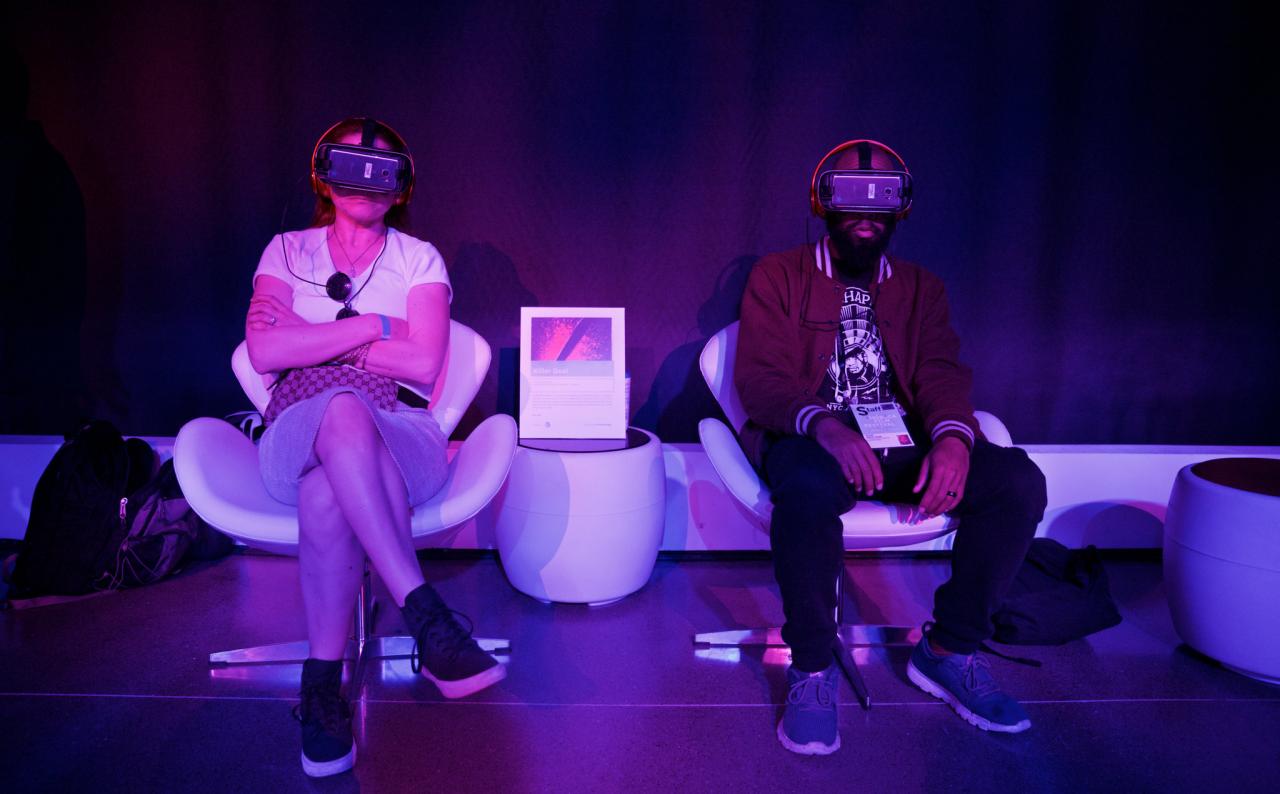This year’s mascot of Tribeca Immersive was a creepy living doll that meandered around the room projecting light in people’s eyes. At the very least, it made the prospect of leaving actual reality for a virtual one a little more appealing.
With its Immersive slate the Tribeca Film Festival, which closes Sunday night in New York, again brought together a selection of the most promising virtual reality, augmented reality, 360 video and interactive storytelling experiences. This year it packed more than 35 projects into its festival headquarters. We checked out every single one, from the creepy to the cute, including the living-doll experience Gymnasia that was a little bit of both.
Events like Tribeca serve as a mile-marker for the progress of storytelling in VR and other emerging formats. Like standing a child against a wall on her birthday to notch how much she’s grown, Tribeca offers a way to assess the development of VR and AR. This year’s Tribeca Immersive program comes at a time of tentatively renewed hope for VR.
In the midst of the festival, Facebook revealed it would release its Oculus Quest headset later this month, and early reviews have kindled speculation that the gadget could finally spark some mainstream interest in VR. Virtual reality was one of technology’s buzziest trends in the last half decade, but its hype fizzled as widespread adoption proved elusive. Consumers en masse were ambivalent about these strange boxes you strap to your face.
But with the appearance of a promising headset, Tribeca’s best experiences feel more relevant than in past years. One of Tribeca’s projects, Bonfire, will be a launch title on Quest.
Below is our summary of the best of Tribeca’s Immersive program. This story will be updated as more CNET reporters and editors submit their impressions.
We’re all stars now in the freak show
Everyone who visited Tribeca’s virtual reality parade this year met its spooky grand marshal: an oversized, decrepit porcelain doll gliding up and down the arcade on a glowing overhead-projector cart. The doll plays a starring role in Gymnasia, one of a handful of experiences designed to subtly freak you out. 
Gymnasia is a playfully creepy VR experience that’s menacing only to the degree you believe dolls can really come to life and murder you. It opens in what looks like an empty, bombed-out grade school gym. Slowly, amid echoes of ball games and children’s choir recitals, inanimate objects in the room bounce, move and — in the case of the dolls — look at you. The project blends 360-degree video with CGI and stop-motion animation of miniatures.
Ayahuasca is another VR experience teed up to unnerve the unsuspecting participant. The project replicates the experience of a shaman-led ayahuasca trip, reproducing Brazilian native imagery and chanted recitations. But if you have any snake or insect phobias, this trip is definitely not for you. A producer of Ayahuasca noted that it’s meant to encourage a meditative state, not only with its lulling smoke and chanting but also by challenging you to keep your even keel when facing writhing snakes.
The rest of Tribeca’s destabilizing immersive projects stuck with more-traditional reasons to get unnerved. War Remains re-creates the sensations of being in a trench in World War I, complete with the ability to reach out and touch the prop dead hand of a soldier’s corpse. 2nd Civil War drops you into a fictitious insurgency in an American city, where you make voice-activated choices that ultimately put a virtual gun in your face, while 7 Lives addresses the idea of resurfacing traumatic memories through a psychological haze, putting you off-balance by presenting everything in unsubtitled Japanese.
Into the light
Tribeca’s creepy projects did have the effect of making the earnest ones feel more buoyant.
The Key was among the buzziest projects, winning Immersive’s Storyscapes award, which recognizes groundbreaking approaches to storytelling and technology.
The Key combines a live actor and a quietly interactive set with a centerpiece VR experience. The VR element itself is largely an allegorical animation, with visual metaphors. In one scene, you’re introduced to three playful floating balls said to be your friends. They dance around you and perform ethereal tricks when you reach out to touch them. But as a windstorm begins to strip your treehouselike room into pieces, you can hold only two of these companions in your hands at once. You come to the anxious realization that the one you choose not to hold onto will be swept away forever, and nothing you do will change that math.
The Key’s VR offers a series of these metaphors evoking a sensation — tedious limbo, a threatening examination — before it flips to photographic realism that explains the underlying meaning of everything you just saw.
Fresh perspectives
For a long time, VR was often inaccessible for many kinds of creators because of its expense. As the tech’s become more consumer oriented, it’s getting into the hands of a wider array of creators, including underrepresented communities that get to show their own points of view.
Future Dreaming nurtured four Aboriginal teenagers to create a story using Tilt Brush painting, motion capture and a head-rig to record their facial expressions as they imagined their own futures. You take a trip with the four teens from their current lives to an intergalactic fantasy future with space mayors, prancing goat steeds and floating pop-star concert performances (preferably with Rihanna as the opening act). It’s a group that’s almost never represented in media, and these teens have total ownership of the product — that authenticity comes through in a rare way. The animation isn’t slickly polished, and it’s not supposed to be. The joy of it is living inside the young creators’ unabashed imagination.
Unceded Territories also presented an indigenous perspective authentically. The subject matter is more serious than Future Dreaming; Unceded Territories grapples with colonialism, climate change and civil rights. But the message is crafted and delivered by First Nations artists: Lawrence Paul Yuxweluptun’s visuals and the music of A Tribe Called Red.
Often in VR’s recent past, during an ’empathy machine’ stage, experiences that focused on native cultures treated them tenderly and respectfully as a subject matter, but the control of the storytelling remained in an outsider’s hands. Projects like Unceded Territories and Future Dreaming show how simply letting communities tell their own stories can make a deeper impression.
